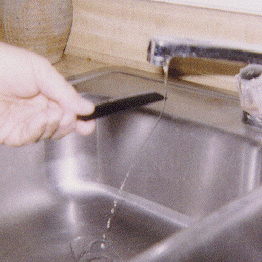Click and expand the tabs below to get started. what you'll need
experimental procedure
Check out this video from Science Off Center and the St. Louis Science Center what's happening
When you run a plastic comb through your hair it pulls lots of very tiny particles called electrons away from your hair. We say these electrons have an electric charge, and when electrons (or other charged particles) move we call this electricity. If lots of extra charged electrons are stuck on the comb and not moving, however, we sometimes call this static electricity. This static electricity creates a force around the comb which can push or pull other charged materials, kind of like a magnet, and it turns out that water molecules are easily pulled by this force. That's why the stream of water from your faucet bends when you hold the charged comb nearby. The closer water is to the comb the stronger the force and the more it moves, but if the comb gets wet it can discharge, allowing those extra electrons to escape, thus there is no force left to pull on the water stream.
more detailed explanation
Everything is made up of matter, matter is made of atoms (which can combine to form molecules), and atoms are made up of protons, neutrons and most importantly for this experiment, electrons. The protons and neutrons are stuck together in the nucleus of the atom, while the much tinier electrons fly around outside the nucleus. It's kind of like the way planets orbit around the sun (the electrons are like the planets and the nucleus is like the sun), but electrons don't follow orderly paths like planets do, it's more like a cloud of electrons (called orbitals) surrounding the nucleus. What keeps electrons from flying away from the nucleus is a force called the electric field force. We say that electrons and protons have an electric charge, or just charge. Electrons have a negative charge (-), protons have a positive charge (+), and charged objects create an electric field that can attract or repel other charged objects (neutrons don't have any charge- they're neutral). Oppositely charged particles attract each other and the closer they are to each other, the stronger the field and the force of attraction. Particles with the same charge (such as two electrons or two protons) repel each other (the closer they are the stronger the field and repulsive force). [BTW- If this reminds you of the way magnets can attract or repel each other depending on their north or south poles and how close they are to each other, you're right. Electric and magnetic forces (and fields) are actually related to each other, so this is really called the electromagnetic force (and electromagnetic field). This is one of the four fundamental forces in nature (see the link below to learn more about this and the other fundamental forces that hold atoms together).] Different types of atoms (called elements) and the molecules they combine to form may be stronger or weaker when it comes to attracting and holding onto their electrons. In our case, the molecules that make up the plastic comb hold onto their electrons much more strongly than the molecules which make up your hairs hold onto their electrons. When you comb your hair, some of the comb's molecules get very close to some of the hair's molecules- so close, in fact, that the atoms in the comb actually start attracting or pulling on the oppositely charged electrons belonging to the atoms in the hair. Likewise, the hair's atoms also start pulling on the comb's electrons. It's kind of a tug-of-war battle, but with electrons (using the electric field force) instead of rope. Normally most molecules have the same number of negative and positive charges, (so we say they are neutral), but when you take the comb away from your hair some of the hair's electrons are actually pulled away, sticking to the comb's atoms instead (remember that the comb's atoms are stronger at attracting electrons). Thus the comb now has extra electrons- and extra electric charges- and your hairs have too few electrons, so we say the comb is now negatively charged and your hair is now positively charged. That's why your hairs are attracted or stand up if you bring the comb close to your head- because the opposite charges attract each other. The more you comb your hair, the more charges build up, and the stronger the electric field (and attractive force) will be. Charging an object this way is called contact electrification, or the tribo-electric effect (see the reference link below for more detail). This is also commonly called static electricity, but many scientists don't like this name, because electricity is defined as moving electric charges, thus static (non moving) electricity doesn't really make sense. Water molecules are made up of two hydrogen atoms and one oxygen atom attached to form a triangle shape, kind of like Mickey Mouse's head- oxygen is the face and the two hydrogens are his ears. All of the electrons in these atoms move around in such a way that the oxygen corner of the triangle is more negatively charged and the hydrogen corners are more positively charged. This kind of molecule is called dipolar. Since water molecules in a liquid are free to move around and rotate, when you hold your negatively charged comb near a stream of water, the positive (hydrogen) sides of each water molecule are attracted to the comb's electric field and rotate so that they point towards the comb. This means that the side of the water stream closest to the comb is more positively charged and the opposite side of the stream is more negatively charged. Finally, the electric field of the negatively charged comb attracts (or pulls) on the positively charged side of the water stream, while it also repels (or pushes away) the opposite (negatively charged) side of the stream, but since the positive side is closer, the attractive force there is much stronger and the stream of water is pulled towards the comb. If you move the comb to the other side of the stream the water molecules simply rotate again to point the opposite direction, so that the side of the stream closest to the comb is once again more positive, and thus the stream still bends toward the comb. By the way- if you hold a magnet near the stream of water nothing happens. It is neither attracted or repelled by the magnet. But that doesn't mean that water (or anything made mostly of water, like frogs or even people) can't be influenced by a magnetic field- you just need a really powerful magnetic field. In fact, if your magnet is strong enough you can even levitate a frog. Did you notice that if you get the comb wet, it no longer bends the water? The extra electrons that were stuck on the comb are able to move into the water and escape, thus the comb is no longer charged (and no electric field present). Also, if you wet the comb first, then run it through your hair, the water prevents it from grabbing electrons from your hair and charging up, so this doesn't bend a stream of water either. Even a microscopically thin layer of water on the comb, which can happen on a humid day, will prevent it from charging up (if you're having trouble making the experiment work, this may be the problem). variations and related activities
You can also bend the water stream with a rubber (Latex) balloon or plastic rod (PVC plumbing pipe works very well). Just charge them up by rubbing with your hair, a cotton towel or T-shirt or a piece of fur. Try lots of different materials. This related activity (and video) shows you how to charge a balloon or PVC pipe and make some other objects move. Check out the references below for more information about the tribo-electric series and charging different materials.
Try making the faucet drip instead of a continuous stream of water. Are the droplets attracted to the comb? And while you're in the bathroom anyway, take a small piece of toilet paper and dangle it vertically near your comb. It should also be attracted to the comb, because the comb's electric field induces a small electric dipole moment (like a charge) in the paper's molecules that is attracted to the comb. In fact, if you tear the toilet paper into really tiny pieces you can even use the charged comb to lift them right off a table or countertop, and even make them seem to dance! Here is a different way to do this experiment: references and links for more information
Other science website do this experiment:
More on atoms and contact electrification (static electricity): The tribo-electric effect (contact electrification) and tribo-electric series: The fundamental forces within an atom: Induced dipole moments or charges: Have a question or comment? Let us know at the bottom of the page.
Return to Try Science at Home
1 Comment
|







